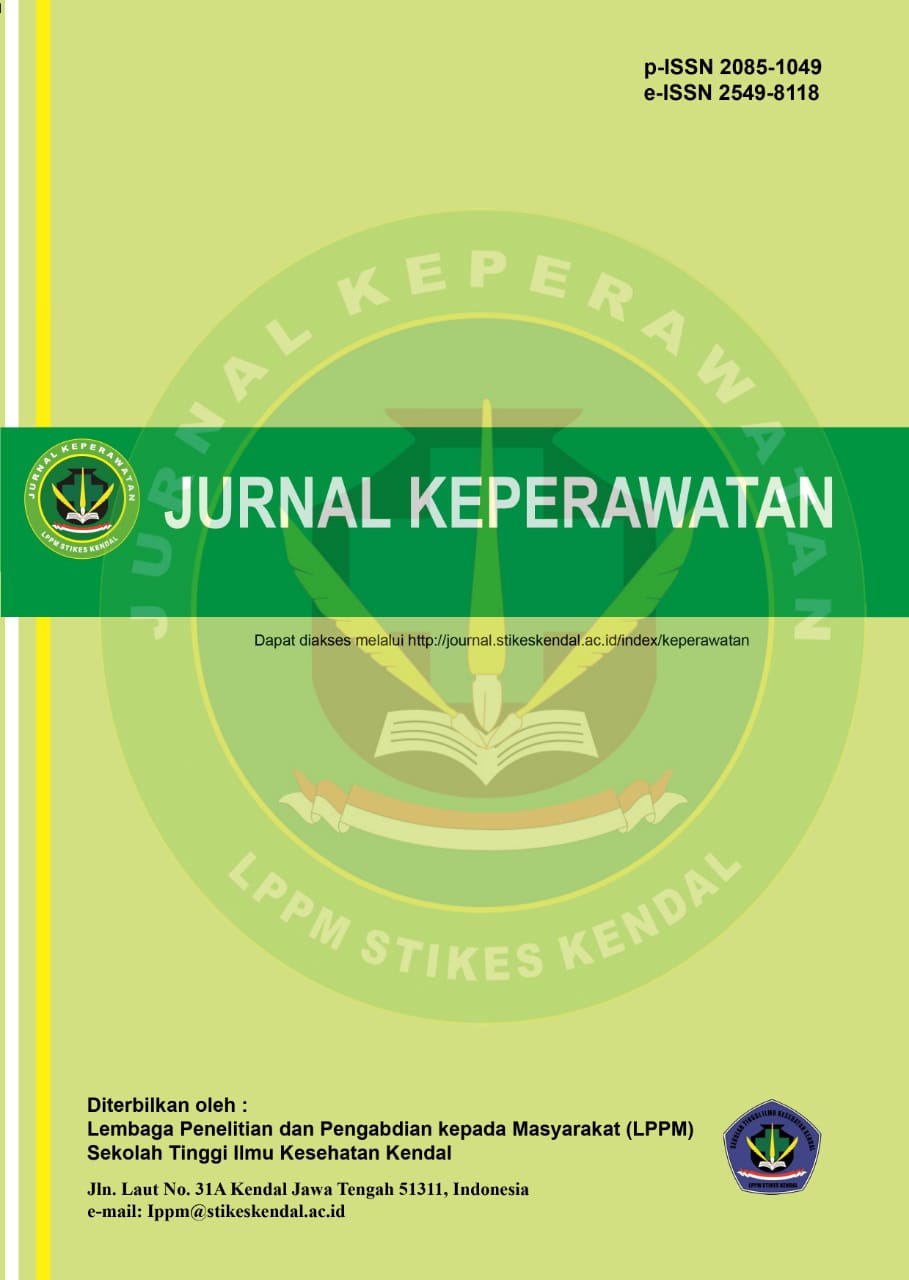Hubungan Efikasi Diri dan Latihan Fisik dengan Status Nutrisi Remaja
DOI:
https://doi.org/10.32583/keperawatan.v16i2.1749Keywords:
efikasi diri, remaja, status nutrisiAbstract
Remaja merupakan aset kesehatan di masa mendatang, namun banyak remaja mengalami masalah nutrisi. Hubungan efikasi diri dan latihan fisik dengan status nutrisi pada remaja di Kota Bekasi merupakan suatu bentuk keyakinan diri sebagai dasar timbulnya keinginan merencanakan dan melakukan kegiatan terencana oleh remaja. Penelitian ini bertujuan untuk menganalisis hubungan efikasi diri dan latihan fisik dengan status nutrisi remaja. Penelitian ini menggunakan pendekatan cross sectional dan pengambilan sampel secara consecutive sampling sebanyak 356 siswa sekolah menengah atas negeri di Kota Bekasi. Hasil penelitian menunjukkan rerata remaja berusia 16 tahun dan berjenis kelamin perempuan 64,9%. Kesimpulan tidak terdapat hubungan yang signifikan antara efikasi diri dan latihan fisik dengan status nutrisi pada remaja (p > 0,05). Rekomendasi perlu peningkatan upaya pencegahan primer dengan optimalisasi kegiatan UKS dan layanan konseling nutrisi remaja.
References
Ardina, R. (2017). Hubungan Antara Dukungan Sosial Dengan Status Gizi Remaja Di Wilayah Kerja Puskesmas Jagakarsa. Universitas Indonesia, 5(2). https://doi.org/10.30872/psikoborneo.v5i2.4375
Astuti, R. F. (2013). Faktor-Faktor Yang Berhubungan Dengan Status Nutrisi Pada Siswa SMA Negeri 3 Tangerang.
Aynehchi, A., Saleh-Ghadimi, S., & Dehghan, P. (2023). The association of self-efficacy and coping strategies with body mass index is mediated by eating behaviors and dietary intake among young females: A structural-equation modeling approach. PLoS ONE, 18(1 January), 1–19. https://doi.org/10.1371/journal.pone.0279364
Badan Pusat Statistik. (2022). Statistik Pendidikan. Media Akademi, February, 1–353.
Benjamin-Neelon, S. E., Platt, A., Bacardi-Gascon, M., Armstrong, S., Neelon, B., & Jimenez-Cruz, A. (2019). Greenspace, physical activity, and BMI in children from two cities in northern Mexico. Preventive Medicine Reports, 14(April), 100870. https://doi.org/10.1016/j.pmedr.2019.100870
BPS. (2022a). Perempuan dan Laki-laki di Indonesia 2022 (A. Chamami, I. Sahara, & M. I. Khoer (eds.)). Badan Pusat Statistik, Jakarta Indonesia. https://doi.org/2104010
BPS. (2022b). Statistik Indonesia 2022. Statistik Indonesia 2022, 1101001, 790. https://www.bps.go.id/publication/2020/04/29/e9011b3155d45d70823c141f/statistik-indonesia-2020.html
Carvalho Souza, G. A., Maia, C. S. C., Oliveira, K. A. de, Marques Braga, R. A., Soares, E. S., Verde, S. M. M. L., Magalhães, S. C., Oliveira, A. C. de, & Loureiro, A. C. C. (2023). Evaluation of the relationship between nutritional status, levels of physical activity and physical strength in adolescents. Clinical Nutrition ESPEN, 53, 182–188. https://doi.org/10.1016/j.clnesp.2022.12.007
CDC. (2021). Adolescent Health. National Center for Health Statistics. https://www.cdc.gov/nchs/fastats/adolescent-health.htm
Cho, D., & Kim, S. (2018). Interplay Between Self-Efficacy and Perceived Availability at Home and in the School Neighborhood on Adolescents’ Fruit and Vegetable Intake and Energy-Dense, Low-Nutrient Food and Sugary Drink Consumption. Journal of Nutrition Education and Behavior, 50(9), 856–867. https://doi.org/10.1016/j.jneb.2018.06.010
Cunningham, K., Pries, A., Erichsen, D., Manohar, S., & Nielsen, J. (2020). Adolescent girls’ nutritional status and knowledge, beliefs, practices, and access to services: An assessment to guide intervention design in nepal. Current Developments in Nutrition, 4(7), nzaa094. https://doi.org/10.1093/cdn/nzaa094
Efthymiou, V., Charmandari, E., Vlachakis, D., Tsitsika, A., Pałasz, A., Chrousos, G., & Bacopoulou, F. (2022). School-Based Multicomponent Lifestyle Intervention. 1–14.
Gali, N., Tamiru, D., & Tamrat, M. (2017). The Emerging Nutritional Problems of School Adolescents: Overweight/Obesity and Associated Factors in Jimma Town, Ethiopia. Journal of Pediatric Nursing, 35(2017),98–104. https://doi.org/10.1016/j.pedn.2017.03.002
Ingersoll, A. B. (2021). Current Evidence-Based Treatment of Obesity. Nursing Clinics of North America, 56(4), 495–509.https://doi.org/10.1016/j.cnur.2021.07.011
Inpres. (2017). Gerakan Masyarakat Hidup Sehat.
Karina, C. Al, Sandra, C., & Herawati, Y. T. (2020). Faktor yang Mempengaruhi Pemanfaatan Pelayanan Kesehatan Peduli Remaja (PKPR) oleh Remaja Sekolah di Wilayah Kerja Puskesmas Bondowoso. Pustaka Kesehatan, 8(2), 93. https://doi.org/10.19184/pk.v8i2.15812
Kemenkes.(2017).Pedoman_Umum_Gentas_Gerakan_berantas_obesitas.pdf (pp. 1–41). http://p2ptm.kemkes.go.id/uploads/N2VaaXIxZGZwWFpEL1VlRFdQQ3ZRZz09/2017/11/Pedoman_Umum_Gentas_Gerakan_berantas_obesitas.pdf
Kemkes. (2018). Kenali Masalah Gizi Yang Ancam Remaja Indonesia. https://www.kemkes.go.id/article/print/18051600005/kenali-masalah-gizi-yang-ancam-remaja-indonesia.html
Kemkes. (2023). Masalah Gizi Pada Remaja. https://yankes.kemkes.go.id/view_artikel/2214/masalah-gizi-pada-remaja
Kumalasari, I. (2016). Hubungan Antara Efikasi diri dan Religiusitas dengan Perilaku Menyontek. Universitas Islam Negeri Maulana Malik Ibrahim, 11–54. http://etheses.uin-malang.ac.id/723/10/10410141 Bab 2.pdf
Liu, P. C., Lin, Y. C., Gau, B. S., Tung, H. H., Hu, S. H., & Chen, C. W. (2023). Association between lifestyle-related, psychosocial factors and obesity among female adolescents in Taiwan. Journal of Pediatric Nursing, 68, e58–e68. https://doi.org/10.1016/j.pedn.2022.11.011
Nashofah Qurrota A’yun. (2021). Pengaruh Efikasi Diri Terhadap Self-Blame Pada Perempuan Yang Pernah Mengalami Pelecehan Seksual Di Tempat Umum. 21–32.
Oikarinen, N., Jokelainen, T., Heikkilä, L., Nurkkala, M., Hukkanen, J., Salonurmi, T., Savolainen, M. J., & Teeriniemi, A. M. (2023). Low eating self-efficacy is associated with unfavorable eating behavior tendencies among individuals with overweight and obesity. Scientific Reports, 13(1), 1–10. https://doi.org/10.1038/s41598-023-34513-0
Razaz, J. M., Balam, F. H., Karimi, T., Rahmani, J., Kalantari, N., Shariatpanahi, S. P., Bawadi, H., Bhagavathula, A. S., & Roudsari, A. H. (2022). Sex Differences in Healthy Eating: Investigating the Moderating Effect of Self-Efficacy. Journal of Nutrition Education and Behavior, 54(2), 151–158. https://doi.org/10.1016/j.jneb.2021.05.011
Report, G. N. (2019). Child and adolescent nutritionstatus.https://globalnutritionreport.org/resources/nutritionprofiles/asia/south-eastern-asia/
Riskesdas. (2018). Laporan Nasional Riset Kesehatan Dasar 2018. In balitbang (p. 198). http://labdata.litbang.kemkes.go.id/images/download/laporan/RKD/2018/Laporan_Nasional_RKD2018_FINAL.pdf
Silveira, E. A., Mendonça, C. R., Delpino, F. M., Elias Souza, G. V., Pereira de Souza Rosa, L., de Oliveira, C., & Noll, M. (2022). Sedentary behavior, physical inactivity, abdominal obesity and obesity in adults and older adults: A systematic review and meta-analysis. Clinical Nutrition ESPEN, 50, 63–73. https://doi.org/10.1016/j.clnesp.2022.06.001
WHO. (2020). WHO Guidelines on physical activity and sedentary behaviour. In Routledge Handbook of Youth Sport. who.int/publications/i/item/9789240015128
WHO. (2023). Adolescent and young adult health. World Health Organization. https://www.who.int/news-room/fact-sheets/detail/adolescents-health-risks-and-solutions
Yu, H., Yang, L., Tian, J., Austin, L., & Tao, Y. (2022). The Mediation Role of Self-Control in the Association of Self-Efficacy and Physical Activity in College Students. International Journal of Environmental Research and Public Health,19(19).https://doi.org/10.3390/ijerph191912152.
Downloads
Published
How to Cite
Issue
Section
License
Copyright (c) 2023 Jurnal Keperawatan

This work is licensed under a Creative Commons Attribution-NonCommercial-NoDerivatives 4.0 International License.




